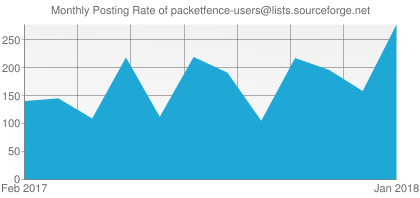Community
Community support is offered through the mailing lists. You can subscribe to them and ask questions related to PacketFence.

-
Public announcements (new releases, security warnings, etc.)
-
Discussion of PacketFence development
-
User and usage discussions
The PacketFence community is very large and active so do not hesitate to subscribe to the mailing list and ask questions. However, please make sure to respect the following guidelines when posting a new message:
- search for existing answers consult the archives for previously answered questions
- do not hijack threads don't generate a post by replying to somebody else's message and changing the subject and text; newsreader software will see your post as a part of the same thread and mix the two subjects, to everyone's confusion
- send plain text message (no HTML or Rich Text) to avoid getting rejected by the spam filters
- avoid replying to a message on top of the quoted text of the previous correspondence
- be nice you are in effect asking a large group of people to give you some of their time and attention; ensure that your message is relevant to as many of the people receiving the message as possible
New: Community PacketFence Chatbot
Kai Bass, a community member has trained a ChatGPT-based Chatbot to answer common technical questions. Try it here.
Please note that this chatbot is community-driven and is not officially supported by Akamai.
Consulting Services
Network Access Control (NAC) projects are complex in nature because they usually involve many different technologies. We have done hundreds of large-scale deployment projects for prestigious organizations, all around the world. Let us help you make this deployment project a success by using our unmatched expertise!
If you are looking for a PacketFence expert to help you:
- Install, configure, customize and optimize the solution to meet your needs
- Perform a pre or post-implementation audit to make sure your PacketFence deployment performs optimally
- Correct a specific issue with your installation or with components related to it
- Migrate from a previous solution to PacketFence
- Efficiently integrate PacketFence with in-house systems (Active Directory, RADIUS, etc.)
- Develop specific features or add support to new networking equipment
Contact Us
Available Support Package
| Unlimited |
|
|---|---|
| Duration | 1 year |
| Support Method | Support Portal |
| Response Time | 1 hour |
| Support Hours | 24 / 7 |
| Multi-Server | No |
| Notifications | Security / Bug Fixes |
| Bug Fixes | Yes |
| Included Incidents | Unlimited |
| Included Consulting Hours | None - can be purchased separately |
| Cost | $5,000 USD per PacketFence server |
| Order |
Supported operating systems are:
- Red Hat Enterprise Linux (RHEL) 8
- Debian 12
The support packages do not include:
- components installation
- custom development
- preventive system monitoring
- training and documentation
Consulting hours can be consumed for:
- architecture design and review
- migration from another system
- performance tuning
- best practices
Documentation
| Installation Guide | Download PDF Read Online |
| Upgrade Guide | Download PDF Read Online |
| Network Devices Configuration Guide | Download PDF Read Online |
| Clustering Quick Installation Guide | Download PDF Read Online |
| Developer's Guide | Download PDF Read Online |
| OpenApi Specification - REST API (Stable) | Read Online |
| OpenApi Specification - REST API (Development) | Read Online |
| OpenApi Specification - REST API (Per Release) | v13.0 |
FAQ
How can I upgrade PacketFence?
These instructions work for both the full install on Linux and the ZEN virtual appliance.
If you installed PacketFence by following our guides, a simple yum update will not show you newer PacketFence versions as the PacketFence repository is disabled by default.
As always, before you upgrade, read the UPGRADE document. Latest version is available here: https://github.com/inverse-inc/packetfence/blob/stable/UPGRADE.asciidoc
To update the whole OS and PacketFence and its external dependencies on RHEL, do:
yum update --enablerepo=PacketFence
On Ubuntu/Debian, do:
apt-get update
apt-get install packetfence
Bugs
If you encounter a possible bug with PacketFence, you can access our github page.
Please make sure to respect the following guidelines when reporting a bug:
- verify that the bug you found is not already known or even fixed in the trunk version
- make the actual facts very clear; be precise, we need to be able to reproduce the problem
- explain your speculations, if any
- add a screenshot to the ticket if appropriate

